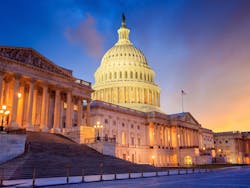Legislation Proposes Federal Tax Credits for Microgrids in US
Microgrids would be eligible for federal clean energy investment or production tax credits under a bill recently introduced by US Sen. Ron Wyden of Oregon.
Wyden’s bill proposes to simplify long-term, performance-based energy tax incentives, replacing a jumble of 44 incentives that exist today. The bill strives for a technology-neutral approach that promotes clean energy and storage.
The proposed Clean Energy for America Act would shelve existing solar investment and wind production tax credits, which are scheduled to be phased out, as well as other clean energy incentives, in favor of investment and production tax credits linked to greenhouse gas (GHG) emissions reductions.
What’s eligible
Two common microgrid resources — energy storage and combined heat and power (CHP) — become eligible for clean energy investment tax credits (ITC) or production tax credits (PTC), the choice being left up to the applicant.
In addition, both microgrid software and hardware, along with demand response, would be eligible for either the clean energy ITC or PTC, according to Max Halik, a senior research associate at Lux Research.
Many of the benefits microgrids offer rely on software-based features, such as intelligent monitoring, real-time data collection, forecasting, analysis and systems management, as well as a new generation of digital power equipment and tools, Halik pointed out in an interview.
“Say, for example, you want to bid microgrid assets into grid markets — demand response or frequency regulation, for example. In many cases this requires additional hardware, such as sensors, as well as additional software, such as controls. The bill says you can get tax credit for that,” Halik said.
Halik sees the bill boosting energy storage more than conventional generation, such as behind-the-meter diesel or natural gas generators, solar or wind.
“It’s possible you could have a microgrid that doesn’t incorporate any generation, and that could qualify for tax credits,” he said.
Pegging clean energy tax credits to local grid emissions
Halik noted that pegging tax credits to projected GHG emissions reductions would pose a challenge. The bill requires the EPA Administrator to calculate the credits based on the projected, “above-baseload” GHG emissions compared to the nearby grid.
The section fails to adequately define the geographic scope of the local grid and would require IRS input, according to Halik.
It’s possible to calculate reference emissions rates in any given area, but you “would need to make a number of assumptions. How do you make those if the geographic scope isn’t clear?” Halik said.
How the bill defines geographic scope would impact how much credit a project could capture. “If you calculated emissions in a part of Massachusetts where there’s a lot of utility-scale solar, the tax credit rate would be low, for example. And if you widen out the geographic scope, say to the New England region, then emissions from different states would factor in,” Halik said.
Furthermore, the bill might wind up boosting investment and deployment where emissions-free renewable energy penetration is already high, Halik added.
“Microgrids are particularly helpful in areas with unstable grid conditions,” he noted. That includes areas with high levels of grid-connected, intermittent solar or wind power.
On the other hand, areas with high renewable energy penetration also tend to have more in the way of natural gas peaker plant generation, which raises emissions.
The tax credits could encourage microgrid development in areas where renewables penetration is high, and emissions low, as compared to areas where fossil-fuel generation, and emissions, are high, according to Halik.
If passed, the tax credits also could prompt microgrid developers to shift their business models, Halik said.
“Right now a lot of microgrids are based on a microgrid-as-a-service models and charged on a monthly cost basis. If they were eligible for tax credits, you might see microgrid and distributed energy resources introduce new options along the lines of more traditional software licensing models,” he said.
However, the bill’s passage appears to be a longshot, given its current lack of Republican sponsorship in the Senate.
Track news about microgrid legislation. Subscribe to the free Microgrid Knowledge newsletter.
